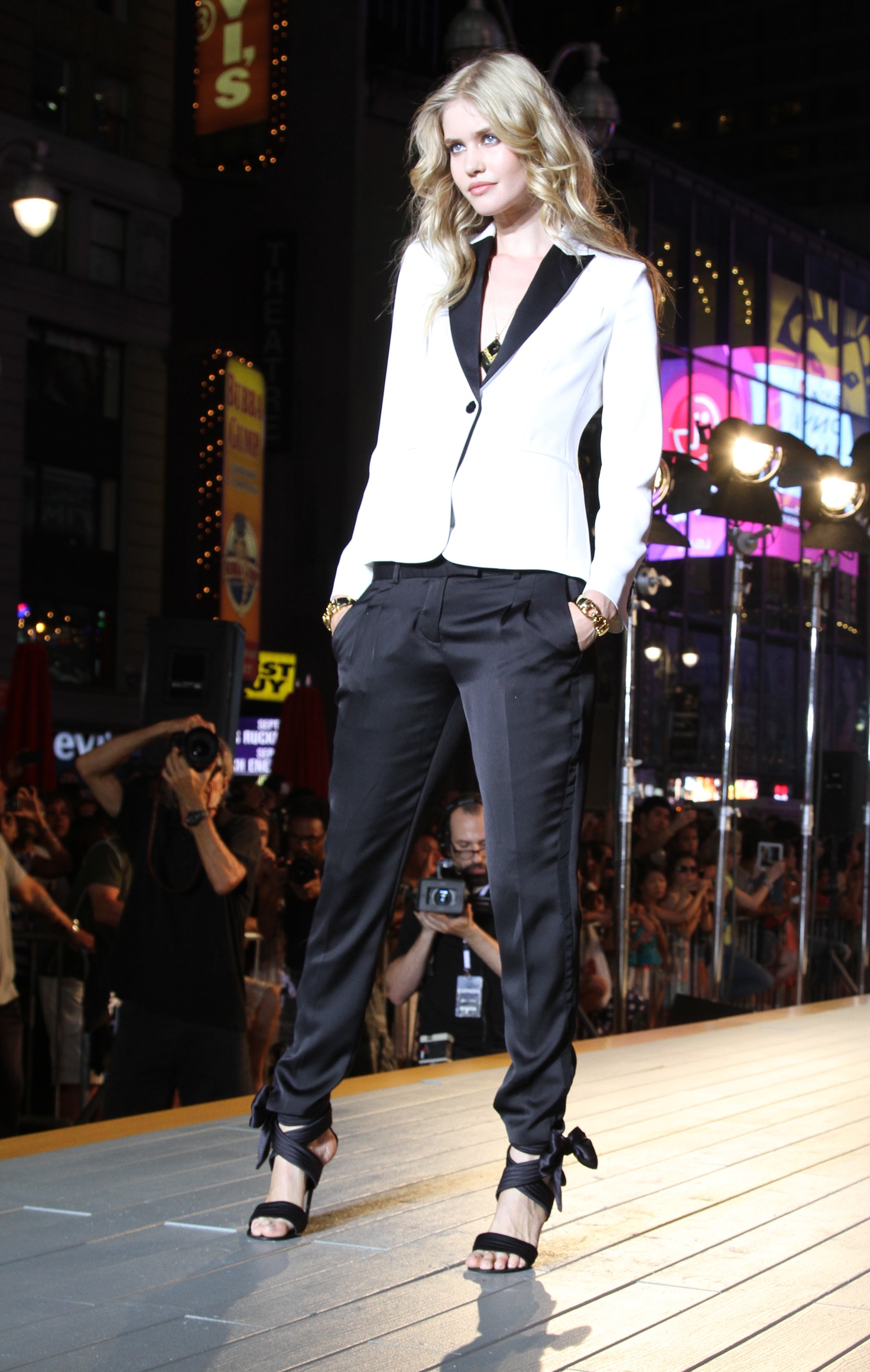Who said tuxedo suits are only for men? Not me, and certainly not the styling women who wear them! Women’s tuxedo suits are classy, elegant and comfortable.
A tuxedo (American English) also known as a dinner jacket (British English), or simply a dinner suit, is a semi-formal evening suit distinguished primarily by satin or grosgrain facings on the jacket’s lapels and buttons, and a similar stripe along the out seam of the pants.
Most tuxedos are black or midnight blue and worn with a formal shirt, top or blouse, although women’s tuxedos in other colors look smashing.
Tuxedo Fun Fact: Tuxedo in the form of menswear originated in the United States around 1888. It was named after Tuxedo Park, a Hudson Valley enclave for New York’s social elite, where it was often seen in its early years. The term was capitalized until the 1930s and at first referred only to the jacket. When the jacket was later paired with its own unique pants and accessories in the 1900s, the term began to be associated with the entire suit.
Complete Tuxedo Garments Include:
- Jacket, Coat or Blazer
- Trousers or Slacks
- Blouse or Top
- Tie or Bow Tie
- Rocking High Heels
- Accessories
- Clutch Bag
Tuxedo Fun Fact: The most popular uses of the tuxedo in the United States at present are for formal weddings, galas, dances, formal proms and formal nights on cruise ships. In these circumstances, the tuxedo’s styling and accessories are most commonly chosen according to the wearer’s tastes.
The tuxedo’s accompaniments have evolved over time. The most traditional interpretation of these elements – formal shirt, formal low cut waistcoat, black bow tie, formal shoes – is incorporated in the black tie dress code.
Be a woman of the town whether you are dressed in a elegant tuxedo suit or a glamorous evening gown!
Women’s pantsuits were introduced in the 1920s, when a small number of women adopted a masculine style, including pantsuits, hats, canes and monocles. However, the term “trouser suit” had been used in Britain during the First World War, with reference to women working in heavy industry. During the 1960s, pantsuits for women became increasingly widespread.
The earliest tuxedo jackets were of the same black material as the dress coat with one, two or no buttons, and a shawl collar faced in satin or ribbed silk. By the turn of the twentieth century, the peaked lapel was equally popular and the one-button model had become standard.
Tuxedo Fun Fact: When tuxedo pants are sold with the dinner jacket, they are the same material. The first tuxedos tended to be black or gray. By World War I, the gray option had fallen out of favor, and midnight blue became an increasingly popular color choice. Notch lapels, imported from the ordinary business suit, were in vogue in the 1920s.
Feminine high fashion in a tasteful tuxedo suit.
Nancy Mangano’s Tuxedo Fashion Tip: Women look sensual and gorgeous in tuxedo suits, and pull the masculine garment into a feminine vibe! Whether you prefer to wear a satin or ruffled blouse under the jacket, or no blouse at all, tuxedo suits give off the fashion effect of classy and confident!
Long diamond earrings and diamond chokers are fabulous accessories to complement your radiant tuxedo suit. Not one to wear real diamonds? Go with the costume jewelry rhinestone look! Just as exquisite with minimal cost.
Although the tuxedo is a form of evening wear, a true glamour girl dresses to her preference. Tuxedo suits work just as well for bridal brunches, speaking engagements or merely to strut your stuff through a mall.
Tuxedo suits work for every woman, one and all.
Tuxedo Fun Fact: ‘Dinner Jacket’ in the context of menswear first appeared in England around 1887 and in the United States around 1889. In the 1960s, ‘dinner jacket’ became associated in the United States with white or color jackets specifically.
Man oh Man! Who’s the lovely woman in the tuxedo suit?

Nancy Mangano is an American fashion journalist, screenwriter and author of the Natalie North murder mystery book series. Visit Nancy on her global online fashion/style/beauty magazine Nancy Marie Mangano Style at https://nancymariemangano.com, her Facebook page Nancy Mangano at https://www.facebook.com/nancymmangano/ Twitter @https://twitter.com/nancymangano and her author website http://nancymangano.com



























